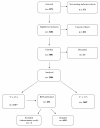Accuracy of a rapid diagnostic test on the diagnosis of malaria infection and of malaria-attributable fever during low and high transmission season in Burkina Faso
- PMID: 20609211
- PMCID: PMC2914059
- DOI: 10.1186/1475-2875-9-192
Accuracy of a rapid diagnostic test on the diagnosis of malaria infection and of malaria-attributable fever during low and high transmission season in Burkina Faso
Abstract
Background: Malaria management policies currently recommend that the treatment should only be administered after laboratory confirmation. Where microscopy is not available, rapid diagnostic tests (RDTs) are the usual alternative. Conclusive evidence is still lacking on the safety of a test-based strategy for children. Moreover, no formal attempt has been made to estimate RDTs accuracy on malaria-attributable fever. This study aims at estimating the accuracy of a RDT for the diagnosis of both malaria infection and malaria - attributable fever, in a region of Burkina Faso with a typically seasonal malaria transmission pattern.
Methods: Cross-sectional study.
Subjects: all patients aged > 6 months consulting during the study periods. Gold standard for the diagnosis of malaria infection was microscopy. Gold standard for malaria-attributable fever was the number of fevers attributable to malaria, estimated by comparing parasite densities of febrile versus non-febrile subjects.
Exclusion criteria: severe clinical condition needing urgent care.
Results: In the dry season, 186/852 patients with fever (22%) and 213/1,382 patients without fever (15%) had a Plasmodium falciparum infection. In the rainy season, this proportion was 841/1,317 (64%) and 623/1,669 (37%), respectively. The attributable fraction of fever to malaria was 11% and 69%, respectively. The RDT was positive in 113/400 (28.3%) fever cases in the dry season, and in 443/650 (68.2%) in the rainy season. In the dry season, the RDT sensitivity and specificity for malaria infection were 86% and 90% respectively. In the rainy season they were 94% and 78% respectively. In the dry season, the RDT sensitivity and specificity for malaria-attributable fever were 94% and 75%, the positive predictive value (PPV) was 9% and the negative predictive value (NPV) was 99.8%. In the rainy season the test sensitivity for malaria-attributable fever was 97% and specificity was 55%. The PPV ranged from 38% for adults to 82% for infants, while the NPV ranged from 84% for infants to over 99% for adults.
Conclusions: In the dry season the RDT has a low positive predictive value, but a very high negative predictive value for malaria-attributable fever. In the rainy season the negative test safely excludes malaria in adults but not in children.
Figures
References
-
- WHO. Guidelines for the treatment of malaria. second. Geneva: WHO; 2010. http://www.who.int/malaria/publications/atoz/9789241547925/en/index.html
-
- Bisoffi Z, Sirima BS, Angheben A, Lodesani C, Gobbi F, Tinto H, Van den EJ. Rapid malaria diagnostic tests vs. clinical management of malaria in rural Burkina Faso: safety and effect on clinical decisions. A randomized trial. Trop Med Int Health. 2009;14:491–498. doi: 10.1111/j.1365-3156.2009.02246.x. - DOI - PubMed
Publication types
MeSH terms
Substances
LinkOut - more resources
Full Text Sources
Other Literature Sources
Medical




